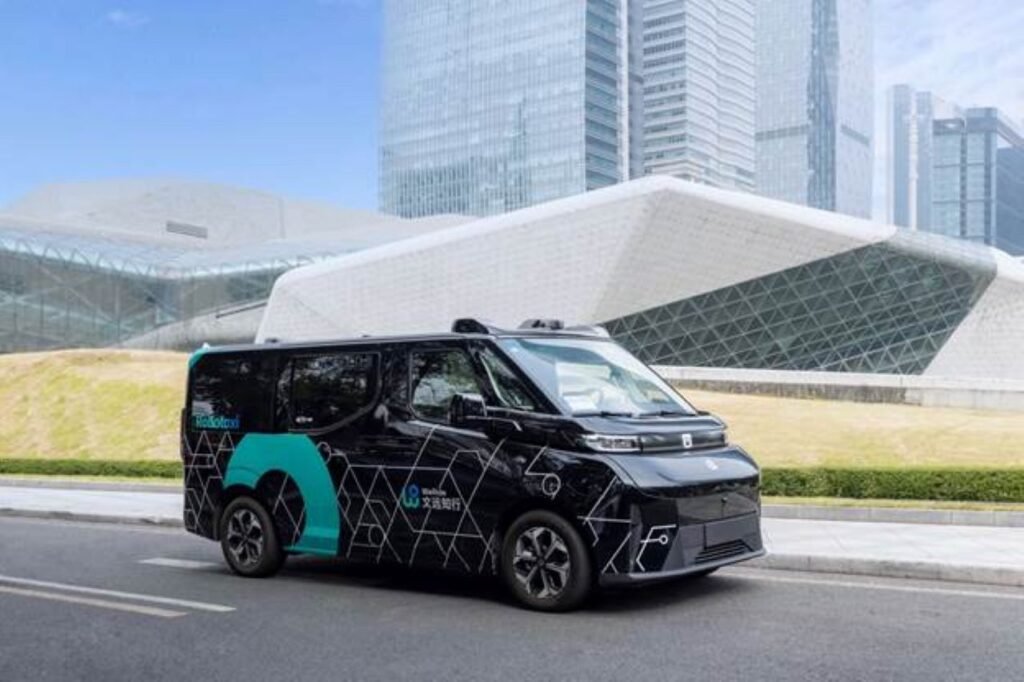Driverless robotaxi Abu Dhabi trials have officially begun as WeRide, a Chinese autonomous driving company, launched its first fully driverless operations in the UAE capital. This is a big moment for Abu Dhabi and the Middle East, as the city becomes one of the few places in the world to test autonomous vehicles without a safety driver on board.
WeRide’s robotaxi trial is part of a larger move by the UAE to become a leader in smart mobility and artificial intelligence. As the country continues to invest in innovative technologies, this new step could help redefine how people travel in the region.
What is a driverless robotaxi?
A driverless robotaxi is a vehicle that uses autonomous driving technology to transport passengers without any human intervention. These cars are fitted with sensors, cameras, GPS systems, and AI software that allow them to navigate city roads, avoid obstacles, and follow traffic rules—all without a driver.

WeRide’s vehicles are electric and designed for urban use, offering a quiet and clean transport option that’s also smart and safe.
Where are the robotaxi trials happening?
The current trial is happening in Yas Island, one of Abu Dhabi’s top tourist and entertainment areas. The location was chosen because of its wide roads, organized layout, and relatively controlled traffic. The area offers a perfect testing ground before the cars are introduced to more crowded parts of the city.

These robotaxis can be booked through a ride-hailing app, just like traditional taxis. However, once the vehicle arrives, there’s no driver inside—only cameras, sensors, and high-tech screens guiding the journey.
No safety driver? That’s right
What makes this trial special is that the vehicles are completely driverless. Most self-driving car pilots around the world still keep a human driver inside the car, just in case. But WeRide’s robotaxis in Abu Dhabi operate without a safety driver, making them fully autonomous.
According to officials, this is a major achievement in both technology trust and regulatory support. It means the UAE is ready to let artificial intelligence take the wheel—literally.
Why Abu Dhabi?
Abu Dhabi is quickly becoming a testbed for futuristic transport solutions. From flying taxis to electric buses, the city has supported various pilot programs and innovation projects. The government is especially focused on smart mobility, aiming to reduce traffic congestion, lower carbon emissions, and improve transportation efficiency.
By allowing WeRide to test its driverless robotaxis, Abu Dhabi sends a clear message: the city is open to disruptive, future-facing technologies.
How safe are these robotaxis?

Safety is always the top concern when it comes to autonomous vehicles. According to WeRide, the robotaxis have passed rigorous tests and simulations before hitting the roads. The cars are loaded with LiDAR sensors, high-definition cameras, radar, and powerful AI algorithms that allow them to:
- Detect pedestrians, animals, and cyclists
- Stop at traffic signals
- Change lanes smoothly
- Avoid accidents in real time
Additionally, the vehicles are monitored remotely by a central control room. In case of an emergency, operators can take over or send help within seconds.
Government support and regulations
The UAE government, especially through Abu Dhabi’s Department of Municipalities and Transport (DMT) and Bayanat, has been a key player in making this trial possible. Bayanat, a geospatial AI company, is partnering with WeRide to ensure the trials run smoothly and safely.
The local authorities have also worked on developing a legal framework to allow driverless operations on public roads, a rare move that shows their trust in the technology.
A step toward commercial launch
This trial is just the beginning. If everything goes well, WeRide could soon move into the next phase—commercial deployment. That means the robotaxi service could be available to the public full-time, not just in Yas Island but also across other parts of Abu Dhabi and eventually the UAE.
The vision is to integrate these smart vehicles into the public transport system, reducing the need for private cars and offering a greener, more efficient way to travel.
Benefits of driverless robotaxis in Abu Dhabi
Here are some reasons why this move matters:
- Reduced carbon emissions: These electric vehicles support the UAE’s green goals
- Lower transport costs: No drivers mean potentially lower fares in the long term
- More accessible mobility: Ideal for the elderly, differently-abled, and those without driving licenses
- 24/7 availability: These cars don’t need breaks, so they can serve passengers any time
What’s next for WeRide in the UAE?

WeRide, which already operates in cities like Guangzhou, Shanghai, and San Francisco, is now looking at the Middle East as a long-term market. The company plans to expand its presence in the UAE and possibly enter Saudi Arabia, Qatar, and Kuwait in the coming years.
The successful trial in Abu Dhabi could serve as a launchpad for that regional growth.
Public response and future outlook
So far, the public response has been a mix of excitement and curiosity. Many people are eager to try the service, while others are still unsure about the safety of riding in a car with no driver. However, as people become more familiar with the technology, experts believe acceptance will grow.
Abu Dhabi hopes that this success will attract more global tech companies to test and launch their innovations in the UAE, creating a thriving ecosystem of smart mobility.
Conclusion: A new era in Abu Dhabi’s transport
The launch of driverless robotaxi Abu Dhabi trials by WeRide is more than just a tech milestone. It marks a new chapter in how the UAE approaches mobility, urban planning, and innovation. As the cars move through the roads of Yas Island without drivers, they also drive the nation forward—into a smarter, safer, and more efficient future.
Read More: 15 Best Bowling Places in Dubai for All Age Groups














